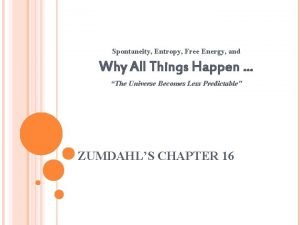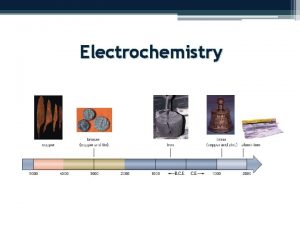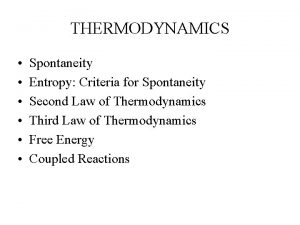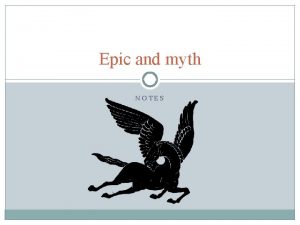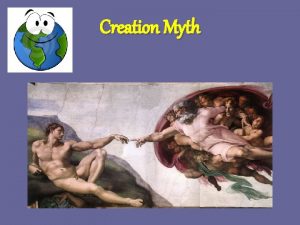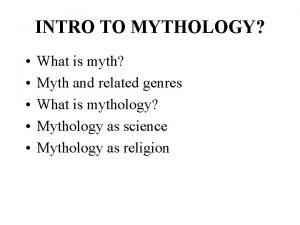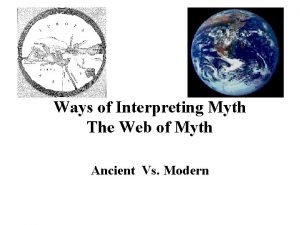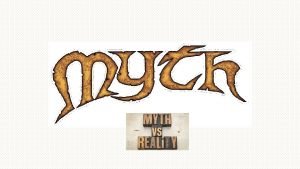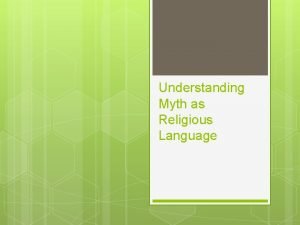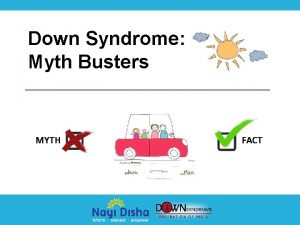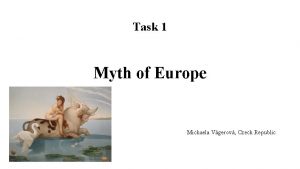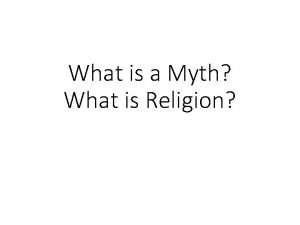Myth 1 The Spontaneity Myth Myth 2 The























- Slides: 23

Myth #1: The Spontaneity Myth

Myth #2: The Leadership Myth

Myth #3: The Failure Myth

Myth #4: The Underclass Myth

Myth #5: The (State or Movement) Benevolence Myth

P. O. S. and the Civil Rights Movement Defeat of Nazi Germany; global human rights discussion. Dawn of TV age. Cold War image of “Land of the Free” and leader of “Free World. ” Changing Electoral Base of Democratic Party; Electoral calculations pursuing Black votes. Civil Rights Movement Anti-colonial struggles.

Classical Model (study pluralist power setup) Better Models (study political context) …widely distributed, diffuse. …concentrated, is redistributed only by consistent, targeted pressure. Elite power-holders are… …highly responsive, constantly seeking greater inclusion. …generally unresponsive, exclusive except when pressured. Coercion is… …a mistake, “political suicide. ” …routine, at the expense of disadvantaged groups. Movements signify… …disruption, disequilibrium. …stabilization, balancing. Social movements are… …extraordinary, abnormal. …ordinary, normal politics. …. psychological. …political. Movement activists are in it for… …emotional, irrational rewards. …fulfilment of rational, pragmatic demands. Severe structural strain is… …sufficient condition for social movements. …necessary condition for social movements. Social movements consist of… …discontented individuals. …coordinated, collective action by mobilized groups. Political power… Movement demands are…

Fascism as Solution, not as Problem Mann’s explanation of the rise of fascism, “the pursuit of transcendent and cleansing nation-statism through paramilitarism” (p. 13) nationalism | statism | transcendence cleansing | paramilitarism Fascist war offered plausible solutions to simultaneous crises in four domains: (1) Ideological (2) Economic (3) Military (4) Political

Michael Mann: I. E. M. P.

Ideological Crisis 10

Subordination of the Individual to the Collectivity The modern, emancipated individual was thought to be disoriented, immoral and miserable. War restores the individual to his subordinate position, gives him transcendent, collective purpose and identity.

Economic Crisis 12

Hitler’s Economic Recovery In 1938, Germany’s federal budget was seven times as large as it had been before the Nazis came to power. • 74% of it was for military purposes. • Mann points out that the rise of authoritarianism was mainly a phenomenon of the underdeveloped countries. “[N]o overall relationship between economic cycles and authoritarian surges in the interwar period” (p. 58). But the rise of fascism was not. Hyper-militarism culminated in highly developed societies, reversing their economies from catastrophe to fascist boom & growth. •

Military Crisis 14

Normalization and Order through Violence • Conservatives and liberals cooperated with Mussolini because his government offered “normalization” of Italian life. • Fascist squadri, paramilitary org’s, brought order one beating at a time. • Paramilitaries brought the war home in peacetime, bringing order. 15

Political Crisis “Schmitt was articulating very widespread fears” (Mann, p. 76). Parliamentary democracy was boring, undemocratic and impotent. Authoritarian regimes, on the other hand, “worshipped order” (Mann, p. 43) and delivered it through paramilitarism.

Cutting out the “Middle Man” Instead of indirect, mediated parliamentary paralysis, fascism gives “the people” direct, unmediated representation by a decisive, charismatic leader. (See Mann p. 34 on the love of “organic” political representation. )

Hobsbawm’s “Social Bandit” Social banditry is a popular form of primitive resistance pervasive in most societies historically. Most social banditry, though not all, is deemed illegal. For Hobsbawm, they are a rural, pre-capitalist and pre-political phenomenon (p. 23). What contemporary examples might we compare?

Bandits as Symbols of Resistance Brigandage in the Two Sicilies, peasant rebellion developed in southern Italy in the early 19 th century Expropriative anarchists, practiced robbery and scams in Argentina and Spain Cangaço, social banditry in Northeast Region, Brazil Hajduk, outlaws in Central and Eastern Europe Betyárs, social bandits in Kingdom of Hungary Klepht, anti-Ottoman insurgents in Greece and Cyprus Rapparee, Irish guerrillas during the 1690 s Williamite war Abrek, Anti-Cossack/Russian guerilla raiders in the North Caucasus, especially Chechnya

Why the mythology? • The obvious reasons are: – Protection: population rarely helps the authorities, as they consider the bandits to be the “peasant’s bandits” deserving aid. – Deterrence: law-enforcement and citizens are more likely to hesitate if there is a myth of “invulnerability” (p. 15), of “immortality” and “superhuman powers” (p. 25). – Business credibility: having certain criminal “tastes” (e. g. robbing only Jews like Schinderbannes, or donating to the Socialist Party like Calabrian bandits) predisposes other criminals or allies with similar business models to cooperate.

But there are some deeper, sociological reasons • The myth of the social bandit is a symbolic, folk sociological substitute for revolutionary social change, which is out of the question. • He is “the poor boy who has made good, a surrogate for the failure of the mass to lift itself out of its own poverty, helplessness and meekness” (p. 22). • Their function is thus not so much to bring justice or equality, but the illusion of justice and equality.

So the mythology is part of a primitive religion of the oppressed “What would happen to people if their champions were irrevocably dead? ” (p. 25) • Themes of revolutionary vengeance and anarchist justice for enemies of the poor permeate social banditry folklore. The myth of the social bandit reclaims HONOR in the name of the poor.

Hobsbawm’s mafias • Characterized by: – Anti-state (anarchist) capitalist attitude. – Omerta code of honor. – High degree of organization (not to be confused with centralization – see p. 33). – Reactionary attitude towards social change. – Dynamic internal divisions (old vs. young, political vs. neutral, flexible vs. traditional). They are in the business of “impressing the sheep – and perhaps also the lions – with the power of the wolves, as well as to set them apart from the herd” (p. 34).
 Entropy ap chem
Entropy ap chem Predicting spontaneity
Predicting spontaneity What is spontaneity in chemistry
What is spontaneity in chemistry Thermodynamics ppt
Thermodynamics ppt Predicting spontaneity
Predicting spontaneity Non standard gibbs free energy
Non standard gibbs free energy Predicting spontaneity
Predicting spontaneity Predicting redox reactions
Predicting redox reactions Gibbs free energy of formation
Gibbs free energy of formation The cell reaction for the zn-h2 cell is
The cell reaction for the zn-h2 cell is điện thế nghỉ
điện thế nghỉ Biện pháp chống mỏi cơ
Biện pháp chống mỏi cơ Một số thể thơ truyền thống
Một số thể thơ truyền thống Trời xanh đây là của chúng ta thể thơ
Trời xanh đây là của chúng ta thể thơ Hình ảnh bộ gõ cơ thể búng tay
Hình ảnh bộ gõ cơ thể búng tay Bảng số nguyên tố
Bảng số nguyên tố Thiếu nhi thế giới liên hoan
Thiếu nhi thế giới liên hoan Fecboak
Fecboak Các châu lục và đại dương trên thế giới
Các châu lục và đại dương trên thế giới Chó sói
Chó sói Thế nào là hệ số cao nhất
Thế nào là hệ số cao nhất Sơ đồ cơ thể người
Sơ đồ cơ thể người Tư thế ngồi viết
Tư thế ngồi viết đặc điểm cơ thể của người tối cổ
đặc điểm cơ thể của người tối cổ


